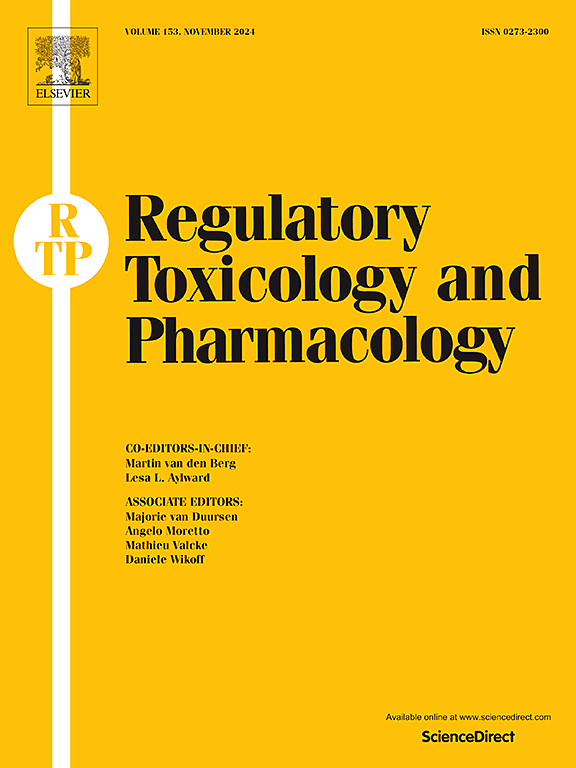Target organ toxicity in Sprague Dawley rats following oral exposure to complex groundwater mixture: Assessment of dose-response relationships using histopathological and biochemical alterations
IF 3
4区 医学
Q1 MEDICINE, LEGAL
引用次数: 0
Abstract
Exposure to contaminant mixtures from industrial legacy sites presents unique challenges that require novel approaches such as effects-directed toxicity assessment. This study characterized the target organ toxicity of groundwater from a legacy contaminated pesticide plant in male and female Sprague Dawley rats exposed to low impact (10% v/v) groundwater, high impact (0.01% v/v, 0.1% v/v, 1% v/v, and 10% v/v) groundwater or tap water (control) for 60 days. Rats exposed to high impact (1% and 10%) and 10% low impact groundwater mixture showed statistically significant increases in liver necro-inflammation relative to control. A statistically significant reduction was observed in plasma albumin of exposed rats (except 0.01% high impact) and alpha 2 macroglobulin (all exposed) when compared to the control. All groundwater-exposed rats showed glomerulopathy, but there were sex-specific differences in acute tubular necrosis. Testes showed germinal cell vacuolation, necrosis, reduced seminiferous epithelial height, and Sertoli syndrome in exposed rats, accompanied by reduced plasma testosterone and increased testicular malondialdehyde. Taken together, this sub-chronic oral exposure to groundwater from a contaminated industrial site caused dose-dependent hepatic and testicular toxicity, while nephrotoxicity was both sex-dependent and dose-dependent. This study provides support for the essentiality of using effects-driven approaches in the risk assessment of complex mixtures.

口服复合地下水混合物对 Sprague Dawley 大鼠靶器官的毒性:利用组织病理学和生化变化评估剂量-反应关系。
暴露于工业遗留场地的污染物混合物带来了独特的挑战,需要采用新的方法,如效应导向毒性评估。这项研究描述了受遗留农药厂污染的地下水对雄性和雌性 Sprague Dawley 大鼠靶器官的毒性,这些大鼠分别接触了低影响(10% v/v)、高影响(0.01% v/v、0.1% v/v、1% v/v 和 10% v/v)地下水或自来水(对照组)60 天。与对照组相比,接触高浓度(1% 和 10%)和 10% 低浓度地下水混合物的大鼠肝脏坏死性炎症在统计学上显著增加。与对照组相比,接触地下水的大鼠血浆白蛋白(0.01% 高浓度影响除外)和甲 2 巨球蛋白(所有接触者)在统计学上有明显降低。所有接触地下水的大鼠都出现了肾小球病变,但急性肾小管坏死存在性别差异。接触地下水的大鼠睾丸出现生殖细胞空泡、坏死、曲细精管上皮高度降低和 Sertoli 综合征,并伴有血浆睾酮降低和睾丸丙二醛增加。总之,亚慢性口服接触受污染工业场地的地下水会导致剂量依赖性的肝脏和睾丸毒性,而肾毒性则具有性别依赖性和剂量依赖性。这项研究证明,在对复杂混合物进行风险评估时,必须采用效应驱动法。
本文章由计算机程序翻译,如有差异,请以英文原文为准。
求助全文
约1分钟内获得全文
求助全文
来源期刊
CiteScore
6.70
自引率
8.80%
发文量
147
审稿时长
58 days
期刊介绍:
Regulatory Toxicology and Pharmacology publishes peer reviewed articles that involve the generation, evaluation, and interpretation of experimental animal and human data that are of direct importance and relevance for regulatory authorities with respect to toxicological and pharmacological regulations in society. All peer-reviewed articles that are published should be devoted to improve the protection of human health and environment. Reviews and discussions are welcomed that address legal and/or regulatory decisions with respect to risk assessment and management of toxicological and pharmacological compounds on a scientific basis. It addresses an international readership of scientists, risk assessors and managers, and other professionals active in the field of human and environmental health.
Types of peer-reviewed articles published:
-Original research articles of relevance for regulatory aspects covering aspects including, but not limited to:
1.Factors influencing human sensitivity
2.Exposure science related to risk assessment
3.Alternative toxicological test methods
4.Frameworks for evaluation and integration of data in regulatory evaluations
5.Harmonization across regulatory agencies
6.Read-across methods and evaluations
-Contemporary Reviews on policy related Research issues
-Letters to the Editor
-Guest Editorials (by Invitation)

 求助内容:
求助内容: 应助结果提醒方式:
应助结果提醒方式:


